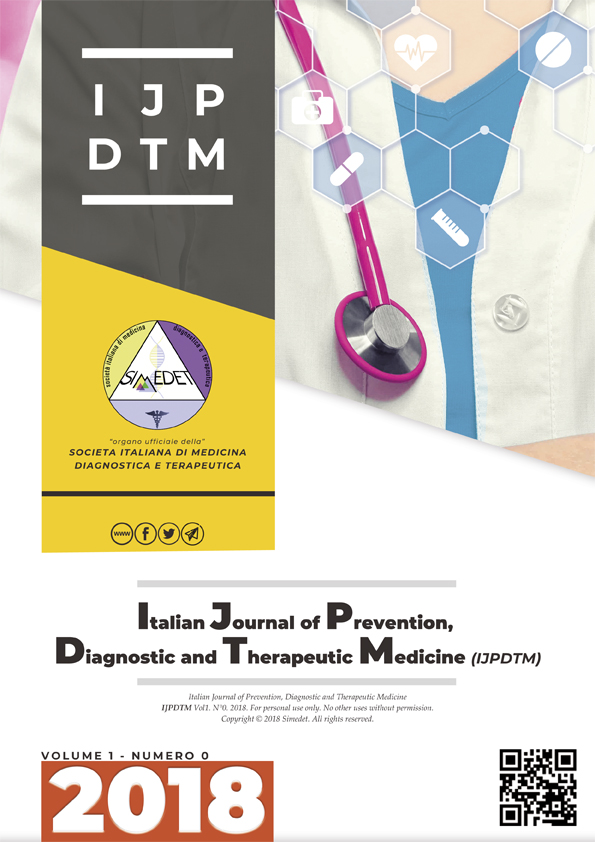Utilizzo del palmare POCUS per accelerare la diagnosi di dissezione aortica
Contenuto principale dell'articolo
Abstract
Si riporta il caso di una donna di 82 anni giunta in Pronto Soccorso presentando
astenia, deficit di forza all’arto superiore sin e dolore toracico lieve.
La valutazione clinica della paziente ha incluso l’utilizzo di un device ecografico
portatile dotato di sonda sector al fine di individuare possibili cause di shock ed
ipotensione. L’esame ha permesso di evidenziare - mediante scansione al giugulo - la
presenza di flapping intimale a livello dell’arco aortico, ponendo il sospetto diagnostico
di dissezione aortica (AD) tipo A.
Il cardiochirurgo è stato immediatamente allertato, nell’attesa dell’esecuzione dell’angio-
TAC toracica (la radiografia del torace non è stata eseguita) che ha confermato il
sospetto diagnostico.
La diffusione dell’ultrasonografia “point-of-care” (POCUS) con device portatili può
migliorare ed accelerare la diagnosi di condizioni critiche quali la AD, patologia
caratterizzata da una mortalità tempo-dipendente e la cui terapia differisce totalmente
da quella di altre condizioni cliniche che può mimare.
ENG: A 82-year-old woman presented to the Emergency Department (ED) with
asthenia, neurological weakness of left arm and mild chest pain.
A portable ultrasound device equipped with a sector probe - used to assess possible causes of shock and hypotension - showed intimal flapping of aortic arc on suprasternal notch scan.
The diagnosis of type A aortic dissection (AD) was confirmed by CT scan, but in the meanwhile the cardiac surgery team had been already alerted.
The use of point-of-care ultrasonography (POCUS) with portable devices can improve and speed up the diagnosis of life threatening conditions as AD which has time related mortality and whose therapy differs from that of other conditions ti may mimics.
Downloads
Dettagli dell'articolo

Questo lavoro è fornito con la licenza Creative Commons Attribuzione - Non commerciale - Non opere derivate 4.0 Internazionale.
Riferimenti bibliografici
Clouse, W. D., Hallett, J. W., Schaff, H. V., Spittell, P. C., Rowland, C. M., Ilstrup, D. M., & Melton, L. J. (2004). Acute Aortic Dissection: Population-Based Incidence Compared with Degenerative Aortic Aneurysm Rupture. Mayo Clinic Proceedings, 79(2), 176–180. http:// doi.org/10.4065/79.2.176
Olsson, C., Thelin, S., Ståhle, E., Ekbom, A., & Granath, F. (2006). Thoracic Aortic Aneurysm and Dissection. Circulation, 114(24), 2611–2618. http://doi.org/10.1161/circulationaha.106.630400
Shirakabe, A., Hata, N., Yokoyama, S., Shinada, T., Suzuki, Y., Kobayashi, N., … Mizuno,K. (2008). Diagnostic score to differentiate acute aortic dissection in the emergency room. Circulation Journal : Official Journal of the Japanese Circulation Society, 72(June), 986–
http://doi.org/10.1253/circj.72.986
Spittell, P. C., Spittell, J. A., Joyce, J. W., Tajik, A. J., Edwards, W. D., Schaff, H. V, & Stanson, A. W. (1993). Clinical features and differential diagnosis of aortic dissection. Mayo Clinic Proceedings, 68(7), 642–651.
Hagan, P. G., Nienaber, C. a, Isselbacher, E. M., Bruckman, D., Karavite, D. J., Russman,P. L., … Eagle, K. a. (2000). The International Registry of Acute Aortic Dissection (IRAD):new insights into an old disease. JAMA : The Journal of the American Medical Association,
(7), 897–903. https://doi.org/joc90321 [pii]
Erbel, R., Alfonso, F., Boileau, C., Dirsch, O., Eber, B., Haverich, A., … Providencia, L. A.(2001). Diagnosis and management of aortic dissection: Recommendations of the Task Force on Aortic Dissection, European Society of Cardiology. European Heart Journal. https://
doi.org/10.1053/euhj.2001.2782
Harris, K. M., Strauss, C. E., Eagle, K. A., Hirsch, A. T., Isselbacher, E. M., Tsai, T. T., … Nienaber, C. A. (2011). Correlates of delayed recognition and treatment of acute type a aortic dissection: The international registry of acute aortic dissection (IRAD). Circulation, 124(18),1911–1918. https://doi.org/10.1161/CIRCULATIONAHA.110.006320
Klompas, M. (2002). Does this patient have an acute thoracic aortic dissection? JAMA :The Journal of the American Medical Association, 287(17), 2262–2272. https://doi.org/10.1001/jama.287.17.2262
Hansen, M. S., Nogareda, G. J., & Hutchison, S. J. (2007). Frequency of and Inappropriate Treatment of Misdiagnosis of Acute Aortic Dissection. American Journal of Cardiology,99(6), 852–856. https://doi.org/10.1016/j.amjcard.2006.10.055
Khan, I. A., & Nair, C. K. (2002). Clinical, diagnostic, and management perspectives of aortic dissection. Chest. https://doi.org/10.1378/chest.122.1.311
Lakoff, D. J., Barghash, M. H., Lorin, S., Ungaro, R., Nguyen, V. T., Baumgardner, J., …Narula, J. (2013). Point-of-care ultrasound and the rapid response system. Global Heart, 8(4),335–340. https://doi.org/10.1016/j.gheart.2013.11.006
Fojtik, J. P., Costantino, T. G., & Dean, A. J. (2007). The diagnosis of aortic dissection by emergency medicine ultrasound. Journal of Emergency Medicine, 32(2), 191–196. https://doi.org/10.1016/j.jemermed.2006.07.020
Rosenberg, H., & Al-Rajhi, K. (2012). ED ultrasound diagnosis of a type B aortic dissection using the suprasternal view. The American Journal of Emergency Medicine, 1–5. https://doi.org/10.1016/j.ajem.2011.11.012
Braverman, A. C. (2010). Acute aortic dissection: Clinician update. Circulation, 122(2),184–188. https://doi.org/10.1161/CIRCULATIONAHA.110.958975
Andrus, P., & Dean, A. (2013). Focused cardiac ultrasound. Global Heart, 8(4), 299–303. https://doi.org/10.1016/j.gheart.2013.12.003
Chenkin, J. (2017). Diagnosis of Aortic Dissection Presenting as ST-Elevation Myocardial Infarction using Point-Of-Care Ultrasound. Journal of Emergency Medicine, 53(6), 880–884. https://doi.org/10.1016/j.jemermed.2017.08.012
Kinnaman, K. A., Kimberly, H. H., Pivetta, E., Platz, E., Chudgar, A., Adduci, A., … Rempell, J. S. (2016). Evaluation of the Aortic Arch from the Suprasternal Notch View Using Focused Cardiac Ultrasound. Journal of Emergency Medicine, 50(4), 643–650e1. https://
doi.org/10.1016/j.jemermed.2015.12.002
Weingart, S. D., Duque, D., & Nelson, B. (2010). Rapid Ultrasound for Shock and Hypotension (RUSH). EmedHome.com, 1–21.
Seif, D., Perera, P., Mailhot, T., Riley, D., & Mandavia, D. (2012). Bedside ultrasound in resuscitation and the rapid ultrasound in shock protocol. Critical Care Research and Practice. https://doi.org/10.1155/2012/503254

